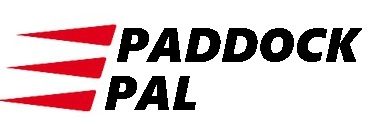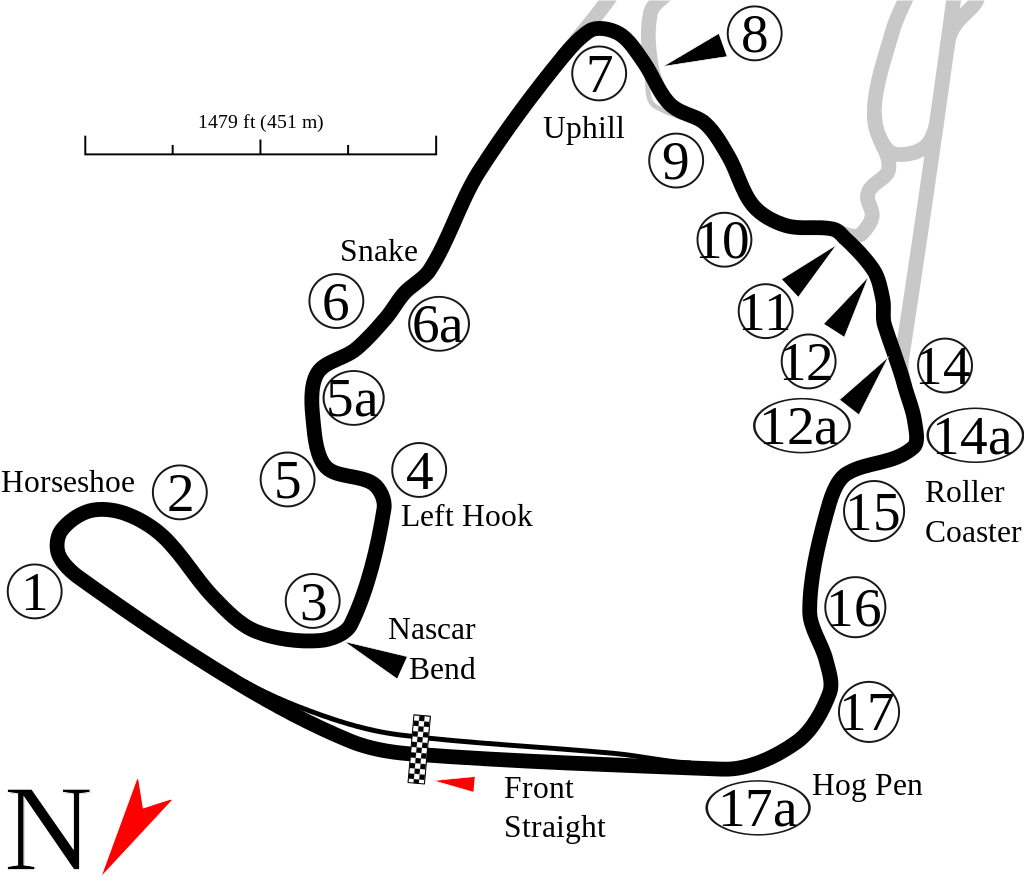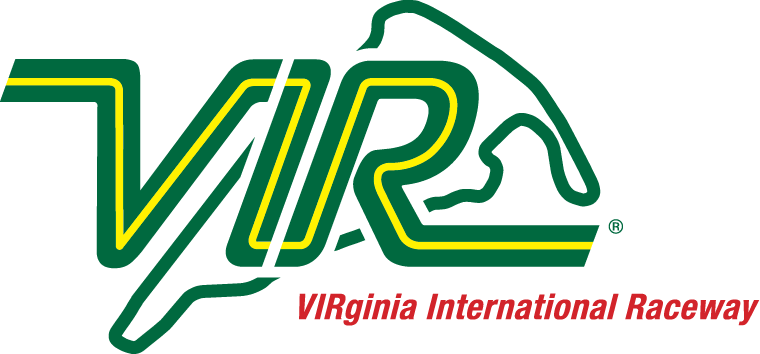
Virginia International Raceway (commonly known as "VIR") is a race track located in Alton, Virginia, near Danville. VIR offers six track configurations, of which two can be run simultaneously. The "Full Course" is 3.27 miles in length while the "Patriot Course" stretches for 1.1 miles entirely inside the Full Course. The "North Course" is 2.25 miles long and the "South Course" covers a distance of 1.65 miles. Both consist of a portion of the "Full Course" and short connecting sections that connect to portions of the "Patriot Course" to produce the two courses that can run simultaneously. There is a second pit complex that is used only when running the "South Course". The longest configuration, "Grand East Course", is 4.2 miles long, and combines most of the "Full Course" and most of the "Patriot Course" by means of two of the short sections of connecting track used to make the "South Course" and "North Course". There is also another, seldom run, long configuration called the "Grand West Course" that uses the other two short connecting sections between the "Full Course" and the "Patriot Course." - Learn more on: Wikipedia
NOTE: This is a dynamic page, if this page is not displaying any data, please use the TRACK GUIDE menu to reselect this venue!
| Travel Guide | Turn-by-Turn |
Paddock (North)
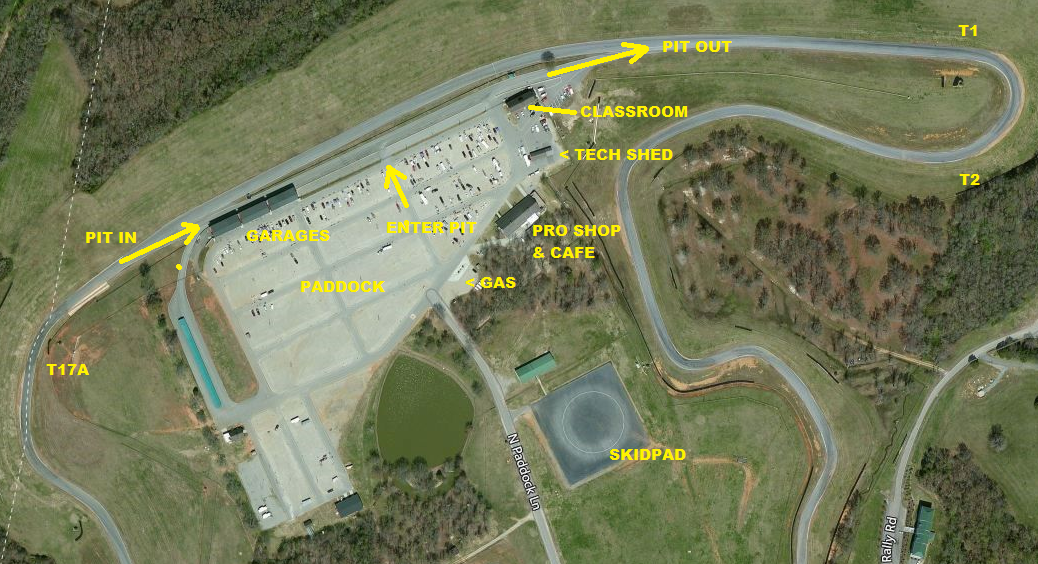
IMPORTANT NOTICE: Post-2017/18 Paddock Re-pave - VIR requires that everyone utilize some sort of "padding" underneath of their jack-stands, floor jacks or anything else that might leave an imprint on the asphalt. Blemishes to the asphalt or chemical spills (fluids, oils, etc) will result in fines from VIR. Check out this article on how to DIY your own jack pads and avoid the fines.
Passing Zones
Note: All passing zone data depicted below is based on "advanced driver" rules, if you are in a different run group please consult your organization or chief instructor for passing zones that are appropriate for your run group.
No Passing Zone information is currently available.Turn-by-Turn
- Turn 1: This is a long and pretty slow right hander following the main straight.Drivers tend to lift on the main straight before their true braking point for turn 1; an easy gain is staying on full power until the braking point, starting to brake hard and immediately shifting attention toward the inside of the turn, looking for the apex.Less experienced drivers tend to turn in too early, which causes them to run out of pavement before the corner finishes. When executing a "traditional" entry (that is, without trailbraking), it is important to go deep into the pavement on the left before starting the turn.The two principal lines through turn 1 are a late apex line and a trailbraking line. The late apex line may be fastest for high horsepower cars, and is a good safe choice while learning the track:
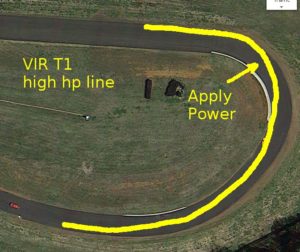 The goal of the late apex line is to be on power as early as possible. This requires slowing down significantly and going in very deep. The apex point should be no earlier than the end of the inside curbing.The more aggressive your entry into turn 3, the more you will benefit from getting on power early, thus increasing your exit speed, in turn 1.Low power cars may find the trailbraking line fastest:
The goal of the late apex line is to be on power as early as possible. This requires slowing down significantly and going in very deep. The apex point should be no earlier than the end of the inside curbing.The more aggressive your entry into turn 3, the more you will benefit from getting on power early, thus increasing your exit speed, in turn 1.Low power cars may find the trailbraking line fastest:
 This line comes with much higher entry speed which is being scrubbed all the way until the apex. The apex itself is somewhere in the second half of the inside curbing. Once you are comfortable with trailbraking into this turn you can start braking significantly later, because trailbraking - due to weight transfer - will make the car turn much better through the first half of the turn, permitting still higher entry speed.
This line comes with much higher entry speed which is being scrubbed all the way until the apex. The apex itself is somewhere in the second half of the inside curbing. Once you are comfortable with trailbraking into this turn you can start braking significantly later, because trailbraking - due to weight transfer - will make the car turn much better through the first half of the turn, permitting still higher entry speed.
You may have noticed that cars on the trailbraking line will track out much earlier than cars on the late apex line.
- Turn 2: This is a transition corner. The line through turn 2 is largely dictated by the approach to turn 3, but at the same time the car must move from track left as it exited turn 1 to track center or track right somewhere in turn 2.
- Turn 3: The character of this turn changed dramatically with the 2014 repave, with the turn becoming much faster and thus demanding much less braking. However the line remains roughly the same as it was before.The two principal approaches to turn 3 is a straight line and a curve. The straight line approach is as follows:
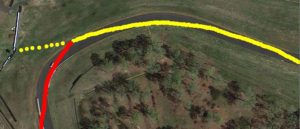 When you are at the apex of turn 2 the car should be aiming at - or facing - the corner station in turn 3. This requires coming pretty far right between turns 1 and 2. With the car aimed at the corner station, drive straight until the car arrives at the right edge of the track; turn in for turn 3 then.Some cars will not need to come out all the way to the right edge of the pavement for turn 3 entry.The alternative is approaching in an arc:
When you are at the apex of turn 2 the car should be aiming at - or facing - the corner station in turn 3. This requires coming pretty far right between turns 1 and 2. With the car aimed at the corner station, drive straight until the car arrives at the right edge of the track; turn in for turn 3 then.Some cars will not need to come out all the way to the right edge of the pavement for turn 3 entry.The alternative is approaching in an arc:
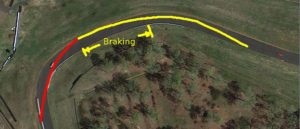 In this approach the car would normally miss the apex in turn 2 and arrange to be much closer to the right edge of the track early. The advantage of the arc line is the smoother entry for turn 3; the disadvantage is that braking must be done in a curve, whereas the straight line offers a straight braking zone.Many drivers coast on the entry to turn 3. The solution to this is to have a good reference point for when to begin braking; I suggest using the inside curb in turn 2 for this purpose.After the repave turn 3 became much faster because its exit became a lot wider. Most cars will fit entirely on the pavement right of the exit curb; using this pavement extension yields a dramatic change in the curvature of the turn.
In this approach the car would normally miss the apex in turn 2 and arrange to be much closer to the right edge of the track early. The advantage of the arc line is the smoother entry for turn 3; the disadvantage is that braking must be done in a curve, whereas the straight line offers a straight braking zone.Many drivers coast on the entry to turn 3. The solution to this is to have a good reference point for when to begin braking; I suggest using the inside curb in turn 2 for this purpose.After the repave turn 3 became much faster because its exit became a lot wider. Most cars will fit entirely on the pavement right of the exit curb; using this pavement extension yields a dramatic change in the curvature of the turn. - Turn 4: This is a slow and tight left hander. The goal in turn 4 is to set up properly for the snake (turns 5-6).Most cars will want to exit turn 4 on the left edge of the track which requires foregoing the traditinal line in turn 4 entirely. The line is normal on the entry but with a much lower speed than in a typical corner, so that the car tracks out very little past the apex as the driver continues to turn left and move over on the left side in preparation for turn 5.Low power and high grip cars can enter turn 4 relatively quicker and track out a bit more, provided they can still make it to the left edge in time for turn 5.
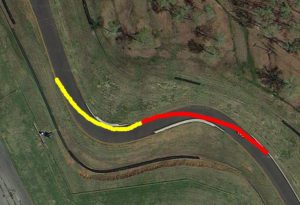
- Turn 5: This sequence of turns 5a-5b-6a-6b is also known as the Snake, and to me this is one of the best parts of VIR.For most cars the turn in point for the Snake is the end of the outside curb between turns 4 and 5a. Many cars would reach the outside edge of the pavement several feet before the curb ends; the correct thing to do is to straighten the steering wheel for half second to a second and wait until the end of the curb to turn in, rather than maintaining constant steering angle and entering 5a too early. That said, low power and high grip cars can sometimes get away with turning in before the curb ends.Cars with strong understeer, especially under power, may find their front end washing out before the apex of 5a, resulting in missed apex. In these cars it's OK to turn earlier, before the curb on the outside ends, to compensate for understeer. Turn 5a is cambered and being off at its apex tends to make the front wash out even more due to camber loss.The radius of the subsequent corners is steadily increasing, permitting most cars to accelerate close to flat out through the snake. Cars which have more power than grip may need to momentarily lift when changing direction for turn 5b, and may benefit from doing the same when entering 5a.
- Turn 6: For optimal lap time turns 6a and 6b should be taken under full power. Adjust the line and attitude of the car in 5a and 5b to make this possible.Larger and more powerful cars frequently have a hard time fitting into the pavement in 6a and 6b. In these cases I apply the aggressive curb cutting line through esses to turn 6a which is the left hander. The left edge of the left front tire would be even with the left edge of the inside curb in 6a, typically under full power; I generally do not use the inside curb in 6b.
- Turn 14: A right hander cresting a hill.This turn benefits from trailbraking in most cars due to elevation change. It is also effectively a late apex turn - the car should come out of turn 14 facing right of the apex of turn 15.
- Turn 15: A downhill left hander. Low power cars should drive through this turn at full throttle. Mid to high power cars will use partial throttle. Do not be afraid to plow the car a little through the turn.Track out all the way right to set up for turn 16a.
- Turn 16A: Turn 16 is the beginning of hog pen. Even though on the map it looks quite open, it is actually pretty slow due to the required setup for turn 16b.Most cars should straighten their line on the right edge of the track between turns 15 and 16a to achieve a late apex entry into turn 16. The car should track out very little past the apex, almost staying on the left edge of the track, to take turn 16b with the best possible line.High power and high grip cars often take an alternative line where they come into turn 16a much faster but do not stay all the way left at the entry for turn 16b. The reasoning for this line is the time given up on entry in 16a is not worth increased exit speed in turn 16b.
- Turn 16B:In low power cars this turn is the begininning of the front straight, and as such exit speed is of paramount importance. Turn 16b should be taken as a late apex corner, with the goal being to apply full throttle at the apex.Higher power cars, especially if they are also grip limited, may not fit into turn 17 regardless of their line in 16b if they go full throttle before the apex in 16b. In such cars it makes sense to take turn 16a faster and take turn 16b more conventionally.Regardless of the car, the earlier the driver can get on throttle in turn 16b, the better their lap time will be. In just about anything the car should be full throttle by the midpoint between turns 16 and 17.
- Turn 17: Turn 17 is an opening right hander. It is a non-event in low power cars and an important corner in high power cars. Look at the end of the exit curb on the left while in this corner to gauge your speed and power application.
Turn-by-Turn Information provided by

©2018 - Oleg Pudeyev / Race & Track Driving ; with Permission.
